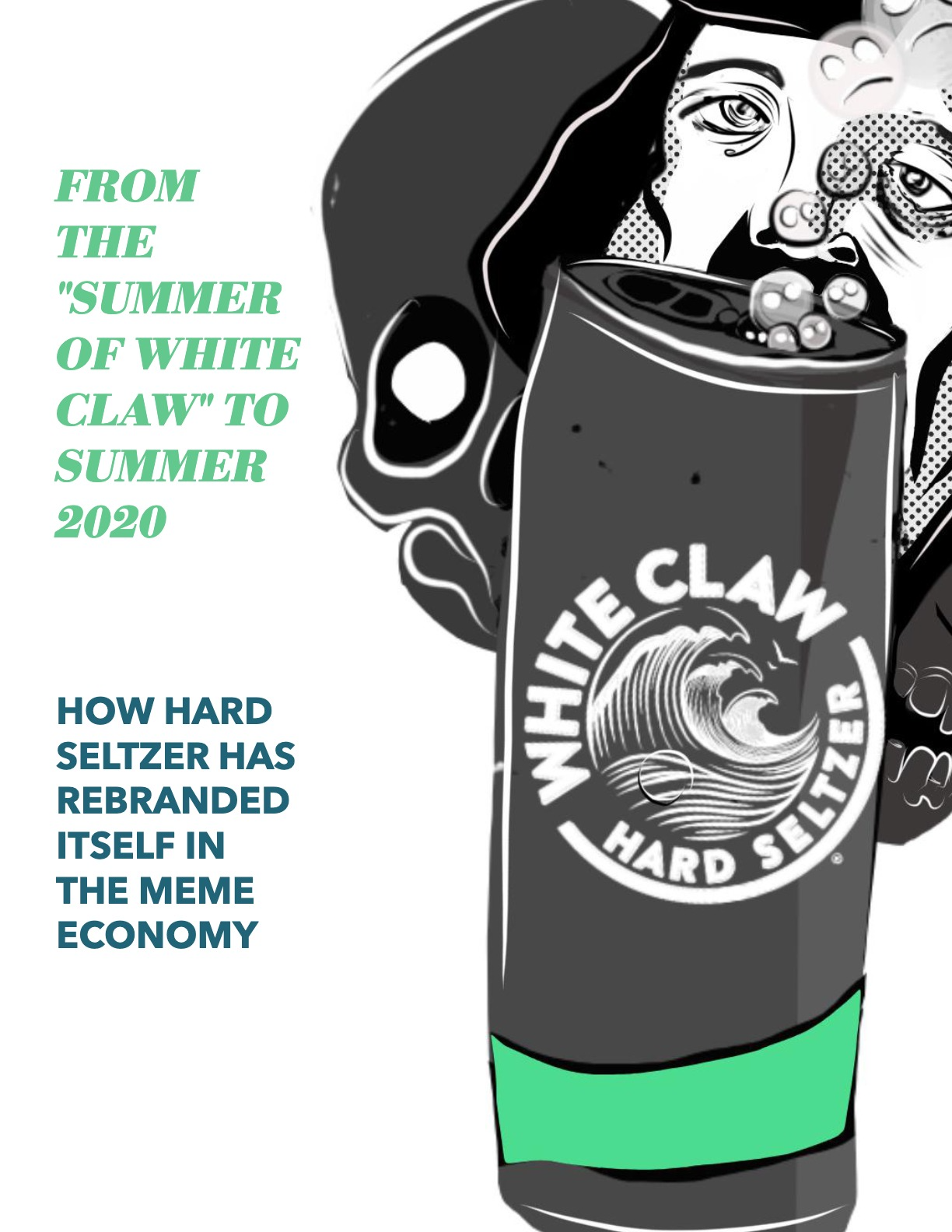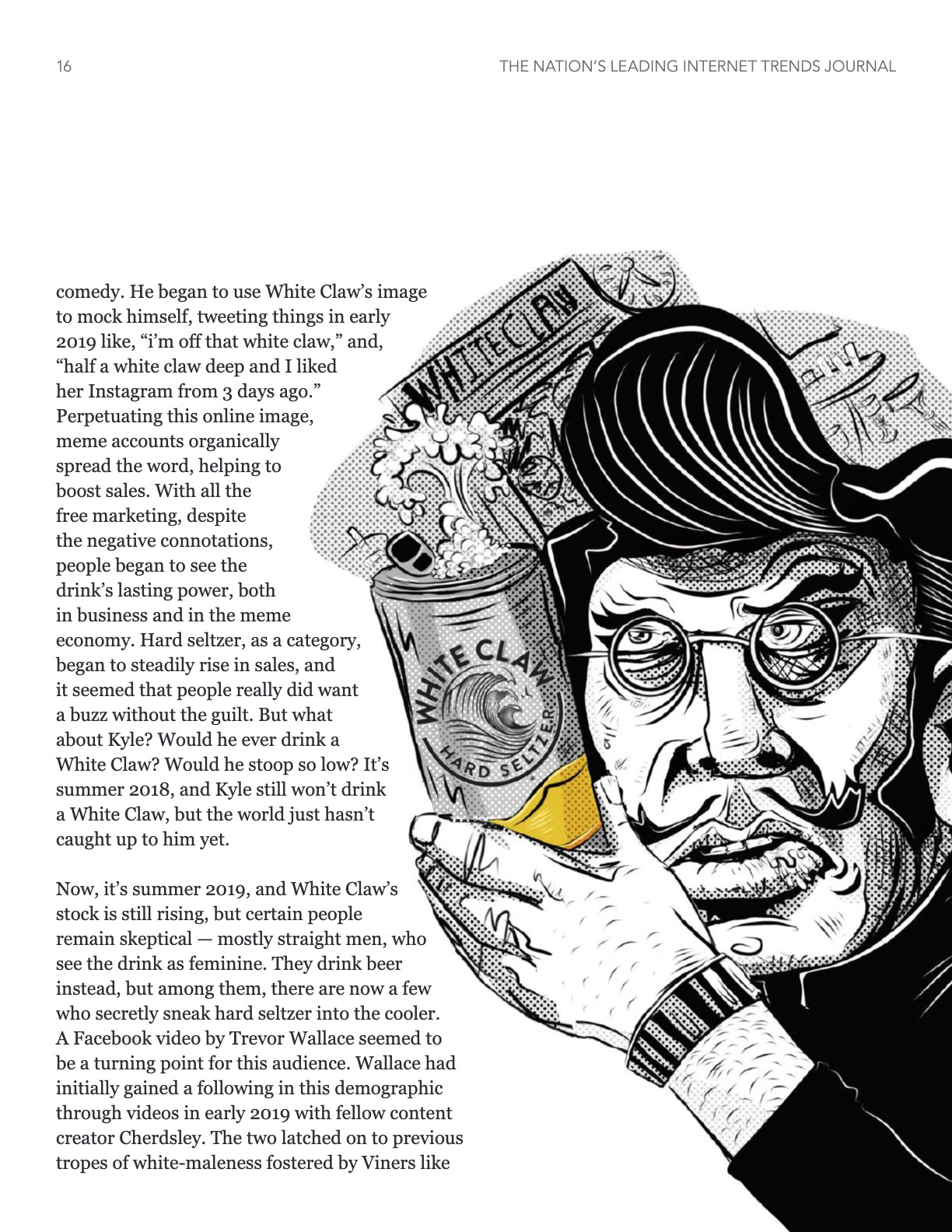September 2020
From The “Summer Of White Claw” To Summer 2020
How Seltzer Has Rebranded Itself In The Meme Economy

At first, it was very quiet. In 2016, White Claw was originally manufactured and had just been introduced to American markets. Although it was on store shelves for years, it wasn’t until 2018 that the internet started catching on. Slowly, the stigma around the brand began to creep in, as basic girls across the country wouldn’t stop posting about it. Becky had seemingly moved on from her pumpkin-spice lattes and avocado toast to White Claws. With it’s round, line-drawn logo like a bad Starbucks rebrand, Becky embraced that clean, white, stainless-steel can mirroring the color of the new Nissan her dad just bought her. Let her sip that White Claw in peace.
But the internet didn’t let her. It seemed anyone online in 2018 who didn’t drink White Claw was poking fun at this stereotype, and it seemed fairly accurate. Using buzzwords like low-cal and affordable, White Claw attracted that type of audience with ease. Naturally, young women into party culture, but not so much the effects on their body and wallet, bought the drink in droves and took it to their local sorority. Of course, this was easy pickings for anyone willing to punch down. The trend began to fester throughout 2018, and the image of the stereotypical White Claw drinker began to solidify in people’s minds.
So as 2019 rolled around, people across all platforms began to take notice, such as Twitter user @CaucasianJames, who was already known for using the awkwardness of whiteness in his comedy. He began to use White Claw’s image to mock himself, tweeting things in early 2019 like, “i’m off that white claw,” and, “half a white claw deep and I liked her Instagram from 3 days ago.” Perpetuating this online image, meme accounts organically spread the word, helping to boost sales. With all the free marketing, despite the negative connotations, people began to see the drink’s lasting power, both in business and in the meme economy. Hard seltzer, as a category, began to steadily rise in sales, and it seemed that people really did want a buzz without the guilt. But what about Kyle? Would he ever drink a White Claw? Would he stoop so low? It’s summer 2018, and Kyle still won’t drink a White Claw, but the world just hasn’t caught up to him yet.
Now, it’s summer 2019, and White Claw’s stock is still rising, but certain people remain skeptical — mostly straight men, who see the drink as feminine. They drink beer instead, but among them, there are now a few who secretly sneak hard seltzer into the cooler. A Facebook video by Trevor Wallace seemed to be a turning point for this audience. Wallace had initially gained a following in this demographic through videos in early 2019 with fellow content creator Cherdsley. The two latched on to previous tropes of white-maleness fostered by Viners like Casey Frey and Nick Colletti, with short videos depicting off-kilter frat bros spouting nonsensical catchphrases. So when Wallace posted his video, titled “*Drinks White Claw Once*,” on June 25, 2019, he already had the social cues of this entire audience under his wing.
By the end of August, the video had garnered over 25 million views across all platforms. Summer 2019, as labeled by Wallace, was now the unofficial “Summer of White Claw.” The men he parodied began to buy the Claw (inherently more masculine sounding) completely out of irony, but how seriously they devoted themselves to this irony is still up for debate.
What these men realized was, is that they genuinely liked what White Claw had to offer: low calories and affordability. Increasingly over the past couple of years, people, in general, have become more health-conscious. For instance, among younger generations, established money-pots (like soda companies) have seen serious declines in overall consumers. People wanted to be healthier, or maybe not necessarily healthier, just skinnier or more attractive. Social media has influence over this, providing constant reminders of perfectionist beauty, and making everyone accountable for their own, sexual marketability. Maybe it’s no surprise that body insecurity has transcended across all genders, and now, brands like White Claw can piggyback off the visual cues and ideas of health and wellness to appeal to all the young people that grew up online.
Just think about Chad: his perfect beauty. Male tropes and alpha stereotypes online have affected, or even just highlighted, existing stereotypes in men, both mentally and physically. As a result, every frat boy’s a male model nowadays because they ditched the beer-belly and opted for the “healthier option.” Needless to say, summer 2019 really was the “Summer of White Claw,” and whether Wallace made the video or not, the Kyles of the world just needed an excuse to dip their toes in.
That summer, the internet was overcrowded with White Claw memes and references. Now it's summer 2020, and things are a bit different. Some of the beaches are still crowded, but what are they doing there? In 2020, the Beckys and Kyles of the world give off a different connotation when you see them on the beach, maskless, partying their butts off.
They’re not just drinking White Claw anymore, by now, the company’s garnered some competition. Even before the brand’s summer 2019 spike, beer companies felt the pressure and launched their own seltzer brands. The company that owns Budweiser (AB InBev) moved to buy a hard seltzer company and marketed it as “Bon & Viv,” which, in its own right, has a Starbucks logo rip-off. Quickly, Bon & Viv generated lots of revenue, and by the time August was halfway through, AB InBev added Natty Light Seltzer to the mix. Historically, Natty Light is a frat house staple. Cheap, low-cal and American, Natural Light has the catchphrase, “Naturdays are for the boys.” So the move aimed to grab this new demographic of White-Claw-closeted men, influenced by Wallace, in an attempt to push them into buying with their loyalty towards Natty, rather than their irony towards White Claw.
It worked, and the demographic obliged. Natty Seltzer proved to be a goldmine. Other brands began to follow suit, such as Bud Light and Corona, but White Claw found its fiercest competitor in the summer of 2019: TRULY. Each seltzer brand vied for their share of the market with their own skinny, white cans -- clean like the color of Kyle’s new Jeep as he pulled into the senior parking lot. It’s summer 2020, and he’s loaded up the Jeep with TRULY and Natty, headed to the beach for the Fourth of July, mid-pandemic, as the older generations watch closely from their iPads in horror. Kyle’s taking a seltzer shot down Becky’s chest because, to him, TRULY’s “straight gas.”
This happened in a recent episode of All Gas No Brakes with Andrew Callaghan. Callaghan went to a crowded beach in Marquette, Michigan, and poked fun at the dissociated college kids partying there. Seltzers everywhere. People shouting, “White Claw!” Even Andrew had a lemon TRULY.
From this frantic scene, it seems that, this summer, hard seltzer has finally moved past White Claw’s original stigma. It’s still the same demographic partying on low-cal drinks, but along with them are the rest of the basic college kids of America, getting drunk with their pretty little cans and clean logos on the beach, juxtaposed against the sprawling, chaotic scene they engage in. This is the lasting image of hard seltzer in the summer of 2020. The aura and memes surrounding the beverage will stem from this image, where hard seltzer, as a concept and visual cue removed from its once humorous perception two years ago, will now stand as a signifier of this weird moment in time. Summer 2020, with its mass conglomerate of colorful, tall cans, will be an easy visual to latch onto for the internet in the days to come.
So, seltzer memes are here to stay, but they won’t be limited to a single brand. Instead, the image of that beach and Kyle taking that TRULY shot will be ingrained in people’s minds as an easy target for the internet. So drink your Natty Seltzer, Kyle. Enjoy it.
click here to read this article in the September 2020 Meme Insider issue.





©owencarry.com